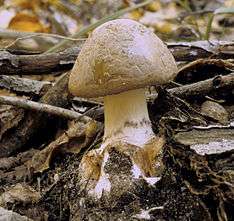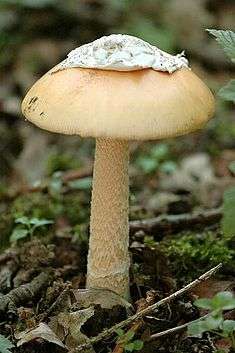Amanita brunnescens
Amanita brunnescens, also known as the brown American star-footed Amanita[1] or cleft-footed amanita is a native North American mushroom of the large genus Amanita. Originally presumed to be the highly toxic Amanita phalloides (the death cap) by renowned American mycologist Charles Horton Peck, it was described and named by George F. Atkinson of Cornell University. He named it after the fact that it bruised brown.[2] It differs from the death cap by its fragile volva and tendency to bruise brown. It is considered probably poisonous.[3]
| Brown star-footed Amanita | |
|---|---|
 | |
| Scientific classification | |
| Kingdom: | |
| Division: | |
| Class: | |
| Order: | |
| Family: | |
| Genus: | |
| Species: | A. brunnescens |
| Binomial name | |
| Amanita brunnescens G.F.Atk. (1918) | |
| Amanita brunnescens | |
|---|---|
float | |
| gills on hymenium | |
| cap is convex | |
| hymenium is free | |
| stipe has a ring and volva | |
| spore print is white | |
| ecology is mycorrhizal | |
| edibility: not recommended | |
See also
References
- Tulloss, R. "Amanita brunnescens G. F. Atk". Amanitaceae.org. Retrieved 2012-12-27.
- Litten W. (1975). "The most poisonous mushrooms". Scientific American. 232 (3): 90–101. Bibcode:1975SciAm.232c..90L. doi:10.1038/scientificamerican0375-90. PMID 1114308.
- Phillips, Roger (2010). Mushrooms and Other Fungi of North America. Buffalo, NY: Firefly Books. p. 31. ISBN 978-1-55407-651-2.
This article is issued from Wikipedia. The text is licensed under Creative Commons - Attribution - Sharealike. Additional terms may apply for the media files.
